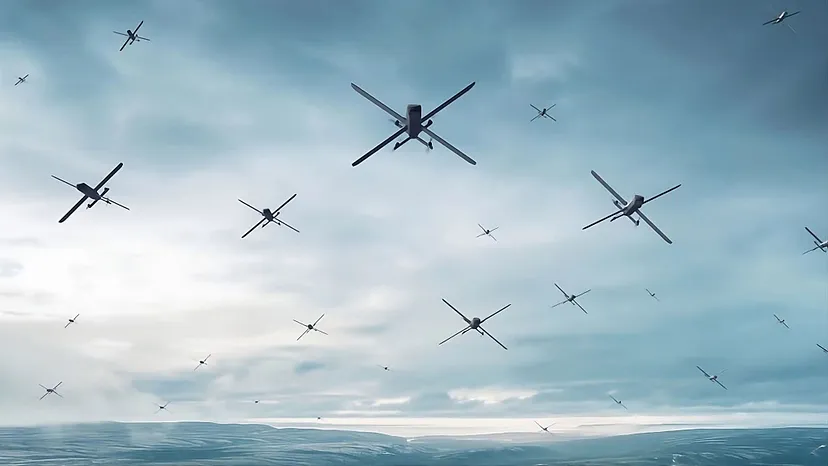Get ready for the Star Wars puns…
Move over, TIE Fighters — the battlefield has its own Rebel tech now. Germany’s Helsing has officially started production of the HX-2 kamikaze drone, a machine straight out of a Star Wars fever dream, designed to boost Ukraine’s military as it faces off against Russian aggression.
This AI-enabled, x-wing-configured marvel is set to deliver thousands of strikes against enemy forces, with 4,000 units scheduled for deployment to Ukraine starting this December. Think of it as Poe Dameron’s X-Wing meeting the grim resolve of a one-way mission.
The Ukrainians have a lot in common with the rebel alliance from the original trilogy. Fighting for freedom against a tyrannical evil empire. Spoiler alert. The rebel alliance wins.
So, what’s this about a German-made X-Wing-shaped, AI-powered, kamikaze drone?
The HX-2 weighs just over 26 pounds (12 kilograms) and reaches speeds of 137 miles per hour (220 kilometers per hour), with a maximum range of 62 miles (100 kilometers). But don’t let its size fool you. This drone is more than just a flying explosive.
But, its true power lies in its AI.

Dubbed “Karma” (which we assume is the bad kind for Russia), this kamikaze drone is resistant to jamming and can find, re-identify, and engage targets even when its connection to a human operator is severed.
Strictly speaking, the onboard AI integrates multi-spectral sensors for autonomous target acquisition and engagement, supported by inertial measurement units (IMUs) and terrain-matching algorithms to maintain precision in GPS-denied environments.
What does that mean? Well, it’s like R2-D2 rebooting your X-Wing mid-battle after the Empire pulls a comms blackout.
The HX-2 essentially operates with a similar level of independence, guided by advanced machine learning systems. Yet, Helsing is clear: no rogue droids here. A human operator remains in the loop for all critical decisions, ensuring ethical standards at a time when drones are becoming increasingly autonomous.
The HX-2 is actually like a mini-Taurus cruise missile, also made in Germany. Like the Taurus, the HX-2 has a low acoustic and thermal signature, enabling stealthy operations against radar and infrared detection.
But the HX-2 isn’t just a “solo” star. Helsing’s Altra software allows a single operator to manage swarms of drones, coordinating them into deadly precision strikes.
Imagine a squadron of X-Wings attacking the Death Star — but in this case, the “target” might be anything from a Russian armored column to troop formations. We haven’t really witnessed true swarm technology yet in this war. This swarm technology could revolutionize Ukraine’s ability to overwhelm Russian defenses.
If it’s not obvious by now, I’m a big Star Wars nerd. I’m just going to put myself on blast and say that I have a Star Wars tattoo. And I got it back in 1998 when getting a pop culture reference permanently displayed on your body was edgy. Now everyone is doing it.
According to reports by BILD, these drones will also be equipped with multi-purpose warheads tailored to different missions — whether it’s taking out hardened bunkers or hitting troop convoys. With their speed and versatility, the HX-2s provide an affordable alternative to costly cruise missiles, packing a strategic punch that even a single-use mission justifies.
The incorporation of AI in weapon systems like the HX-2 sparks heated debates about the ethical implications of autonomous warfare. Critics argue that such technology could lead to reduced accountability or unintended casualties.
What happens when we give the machines the decision-making authority to kill or spare people?
With or without AI, an autonomous weapon system could be programmed to fire on any legal enemy combatant. But here’s where the ethical issues get murky.
For example, when I served as an infantryman, I and a group of others were once tasked with guarding Patriot missile batteries on the Iraq border. Occasionally a Bedouin, his son, and his flock of sheep would venture too close to our perimeter, resulting in the deployment of our Quick Reactionary Force (QRF) to turn them around.

The rules of war allowed us to shoot once our perimeter was “threatened.” But for us, shooting a shepherd and his flock was not an option.
If an AI-controlled robot had been there instead, the outcome may have been very different. Had the robot been programmed to comply with the rules of war, the Bedouin and his son would have been fired upon.
The ultimate question is: How would you design a robot to know the difference between what is legal and what is morally right?
Helsing, however, stresses that it adheres to strict ethical standards, ensuring human oversight at all times. Its stated mission is to deploy AI responsibly while maintaining technological superiority over adversaries willing to “take shortcuts.”
This isn’t just a PR spin. Helsing’s AI capabilities also allow for real-time adaptability. The HX-2’s onboard software can receive updates wirelessly, potentially mid-mission, to counter emerging threats. For a war defined by rapidly shifting tactics, this adaptability makes the drone an indispensable tool.
For Ukraine, the HX-2 represents a critical addition to its arsenal at a time when electronic warfare dominates the battlefield. Both sides have invested heavily in disrupting each other’s drones, often rendering them useless. The HX-2’s resistance to jamming and ability to operate autonomously under such conditions make it a formidable adversary.
Reports suggest prototypes of the HX-2 are already being tested on the frontlines in eastern Ukraine, where they’ve undergone real-world stress tests. Improvements based on these trials will ensure the production models are battlefield-ready when they begin arriving this month.
Ukraine has already demonstrated ingenuity with domestically developed drones, but the HX-2’s advanced AI places it in a league of its own. Bild reports that the HX-2’s range is four times greater than that of its Ukrainian counterparts, making it ideal for deep-strike missions against high-value targets.
The HX-2 reflects a broader trend: the increasing reliance on drones in modern conflicts. From kamikaze UAVs to reconnaissance and strike systems, drones have shifted the balance of power in warfare. And as technology advances, the line between defensive tools and offensive weapons blurs.

I believe we are in a short transitionary period right now where within just five short years we went from large American drones like the MQ-9 Reaper to small, consumer drones on the battlefield (where we are now), to AI-controlled drones that don’t need an operator at all.
Mark my words, in 2025 the world will witness the first AI kill in Ukraine or Syria.
Future historians will look back and say the Ukraine War was where small, consumer drones really became a force on the battlefield. But Russian electronic warfare was so ubiquitous that it forced weapons developers to upgrade the AI to the point where the drone could fly, fight, and win on its own.
If Russian electronic warfare severs the connection between the drone and the operator — just remove the operator.
So, what if Russia fields AI-powered drones?
That’s why it’s smart that the West is supplying Ukraine with kinetic weapons that don’t rely as much on severing the electronic connection, but rather just getting really good at shooting drone swarms out of the sky, like the German Skynex, the Aussie Slinger, and the American Vampire SAM.
These Western systems, by the way, also use complex AI algorithms to plot drone speed, distance, and direction in 3D space much faster than a human can.
So, how long until we have AI going to war against AI, and all the humans just stay home? Rhetorical question.
For Ukraine, the HX-2 offers a vital capability. Without air superiority, traditional airstrikes have been almost impossible to execute. Kamikaze drones like the HX-2 fill that gap, allowing precision strikes far beyond the frontlines.
They’re also cost-effective. Each drone costs significantly less than the missiles or manned aircraft needed for similar missions, and they force adversaries to expend expensive air defense munitions or waste time with complex electronic warfare configurations.
The rollout of the HX-2 may mark the beginning of a larger shift in how nations approach drone warfare. Its affordability and AI-driven features position it as a template for future systems. Whether its impact in Ukraine lives up to its potential remains to be seen, but one thing is clear: the HX-2 isn’t just a weapon.
It’s a signal that the era of AI-powered, networked drone warfare has truly arrived.
So, next time you see an X-winged silhouette streaking through the skies, remember: it’s not Luke Skywalker — it’s Helsing’s HX-2, carving its own legend in the fight for freedom.
Glory to Ukraine, glory to the heroes.
Слава Україні!
And may the force be with you…
Source: https://wesodonnell.medium.com/ukraines-new-ai-driven-x-wing-fighters-take-flight-692d5550e7b2



